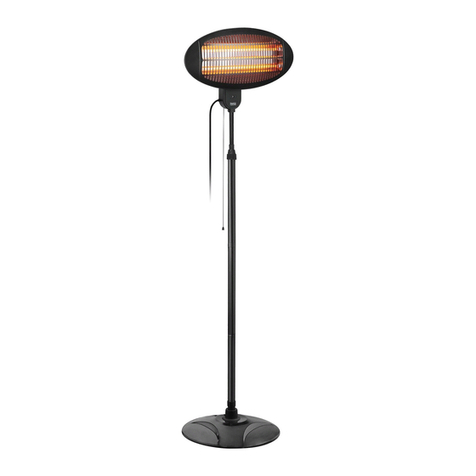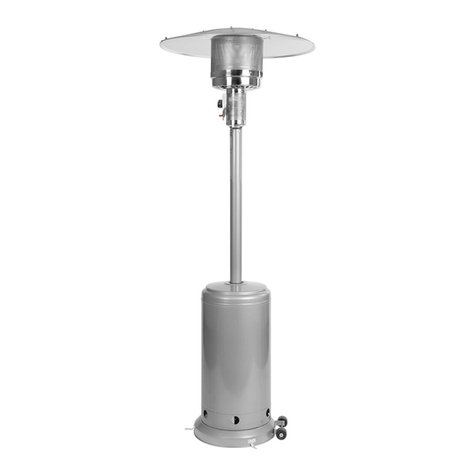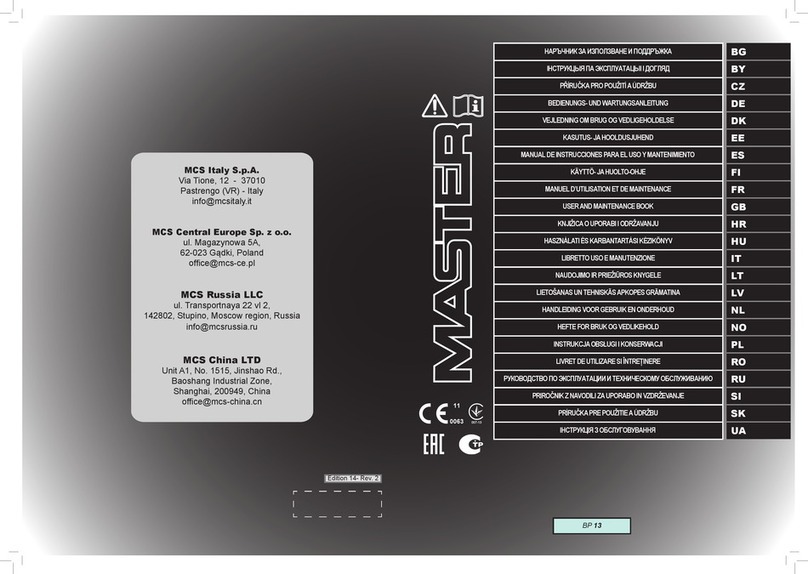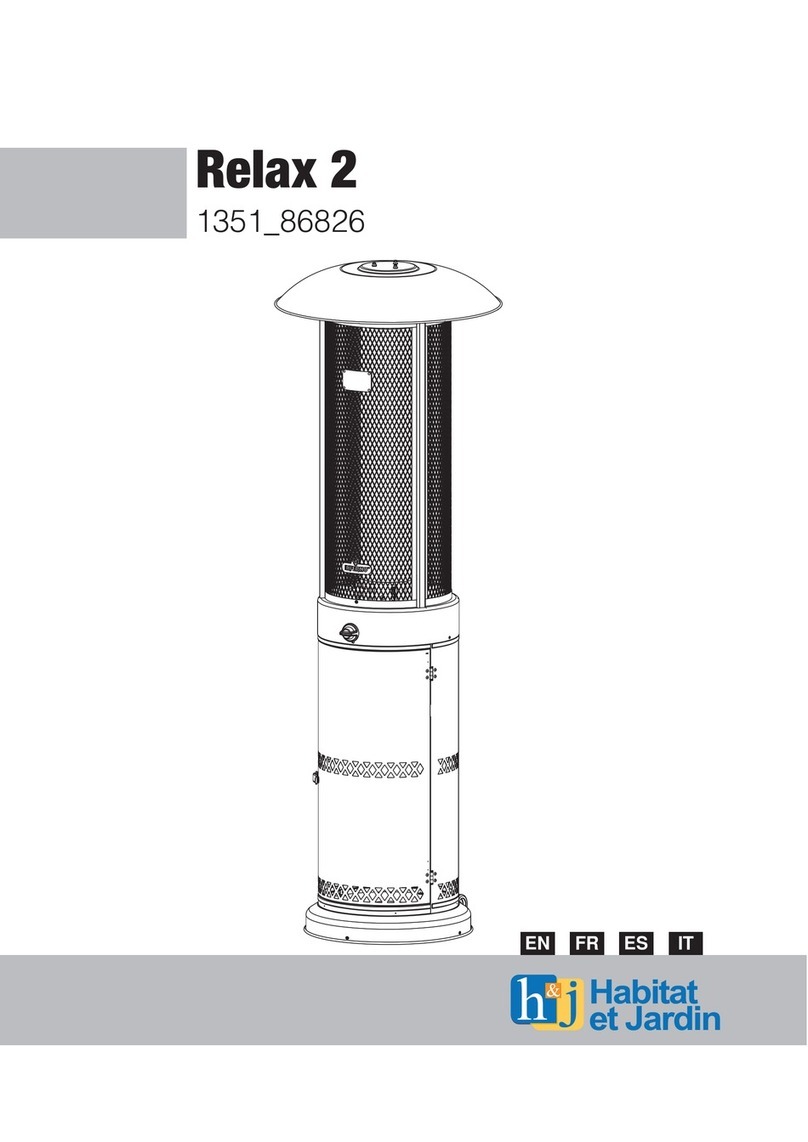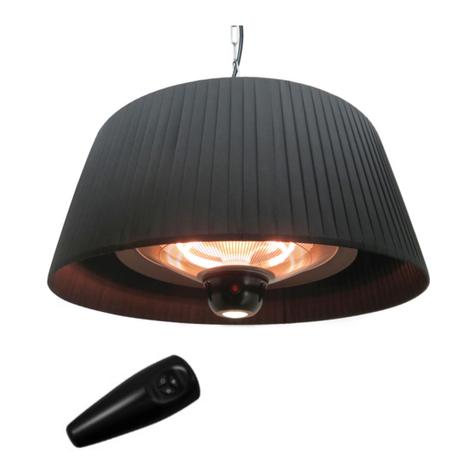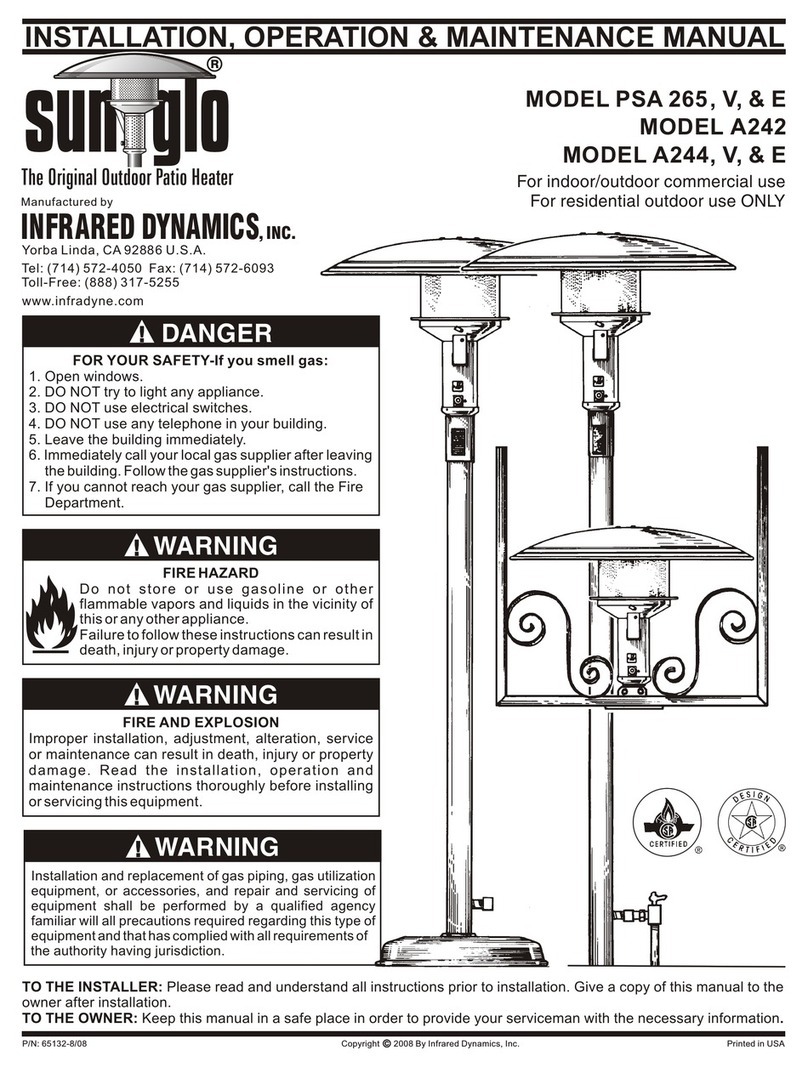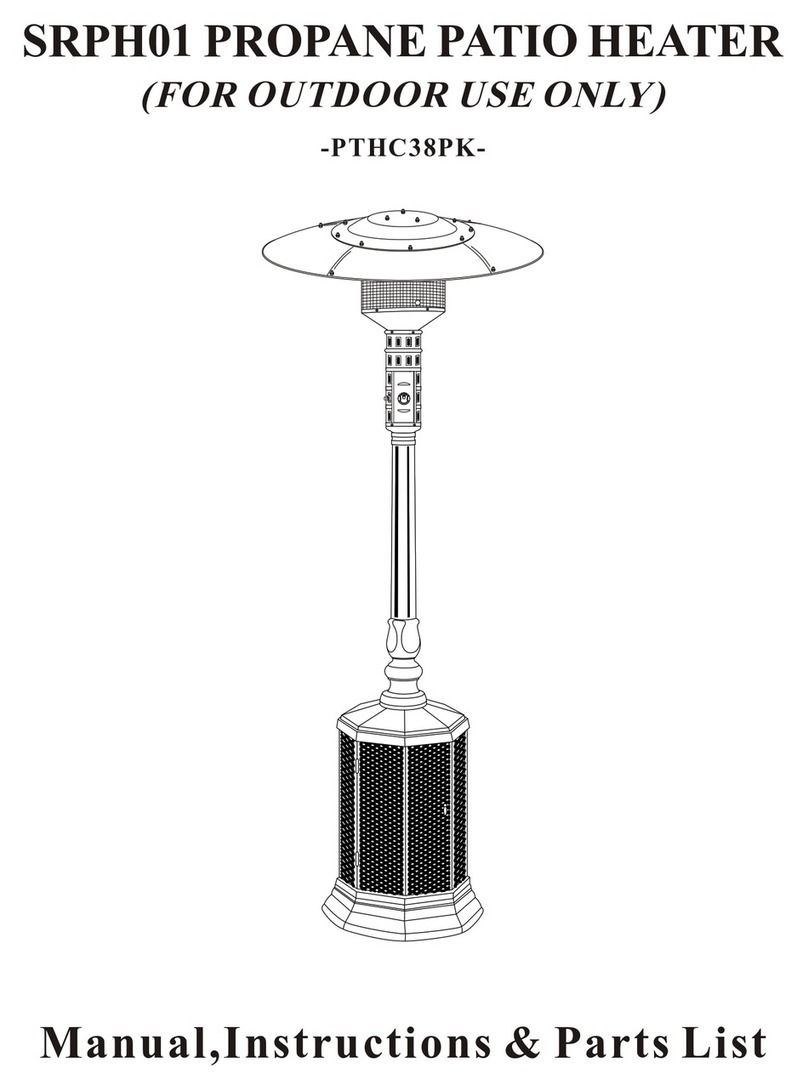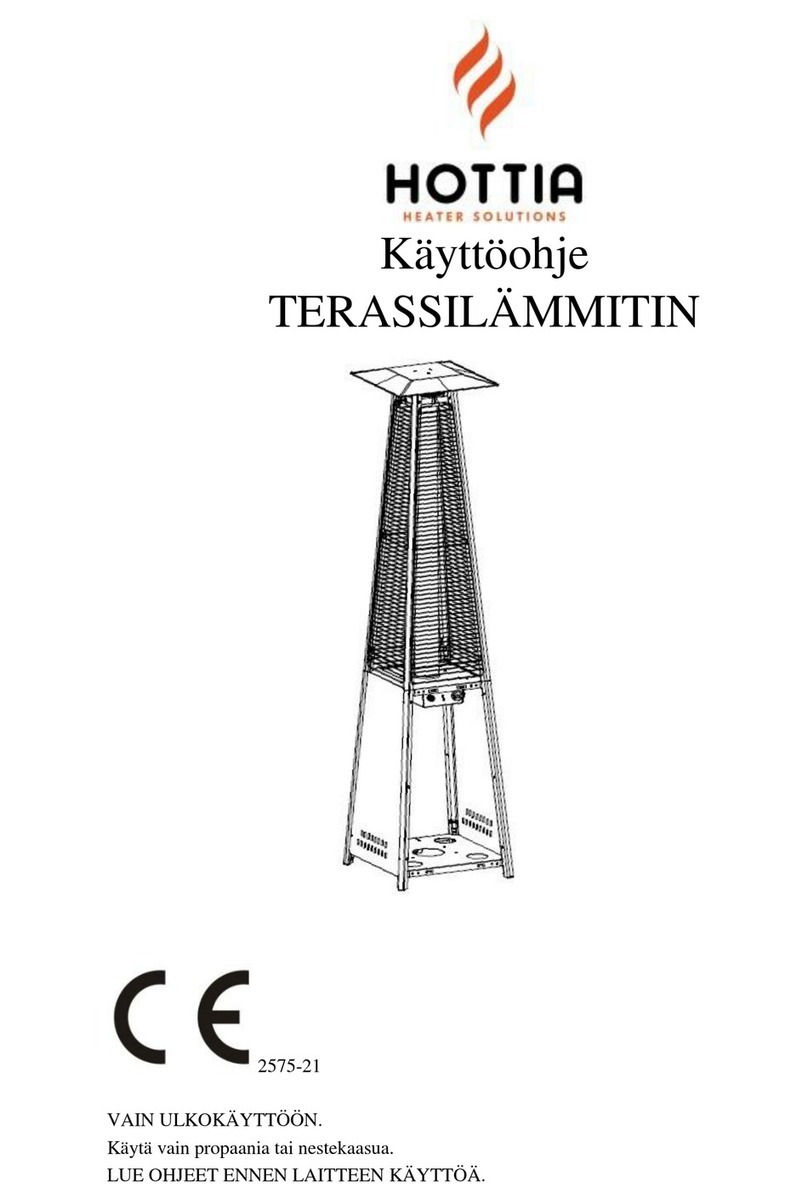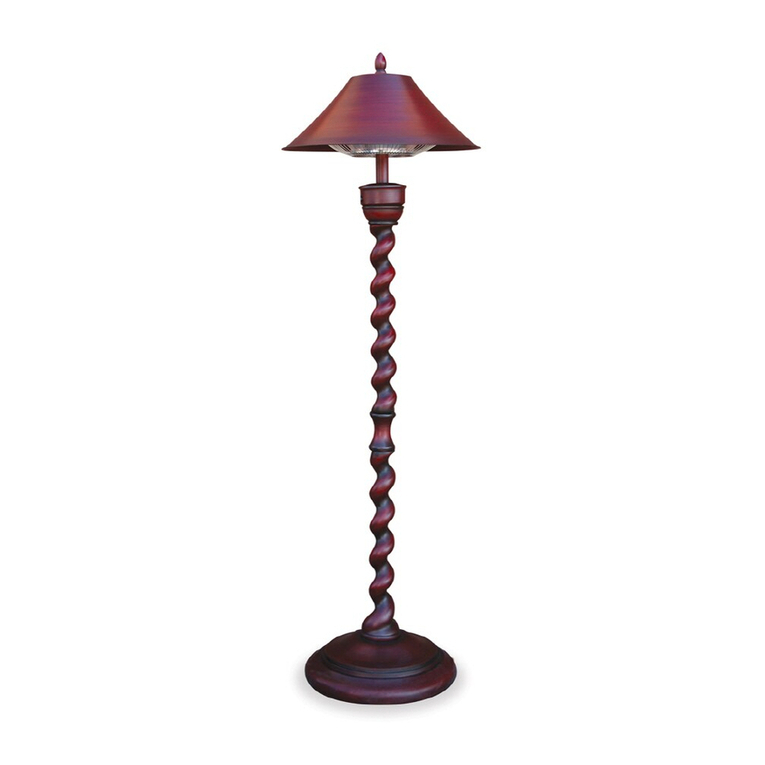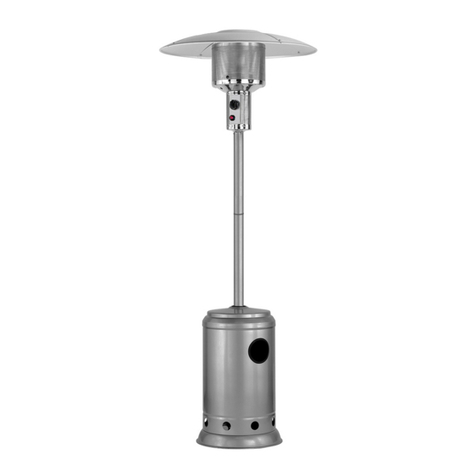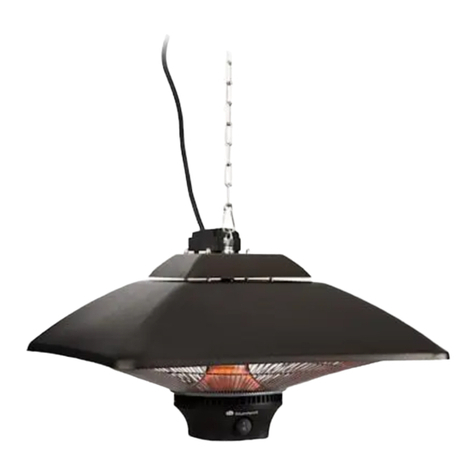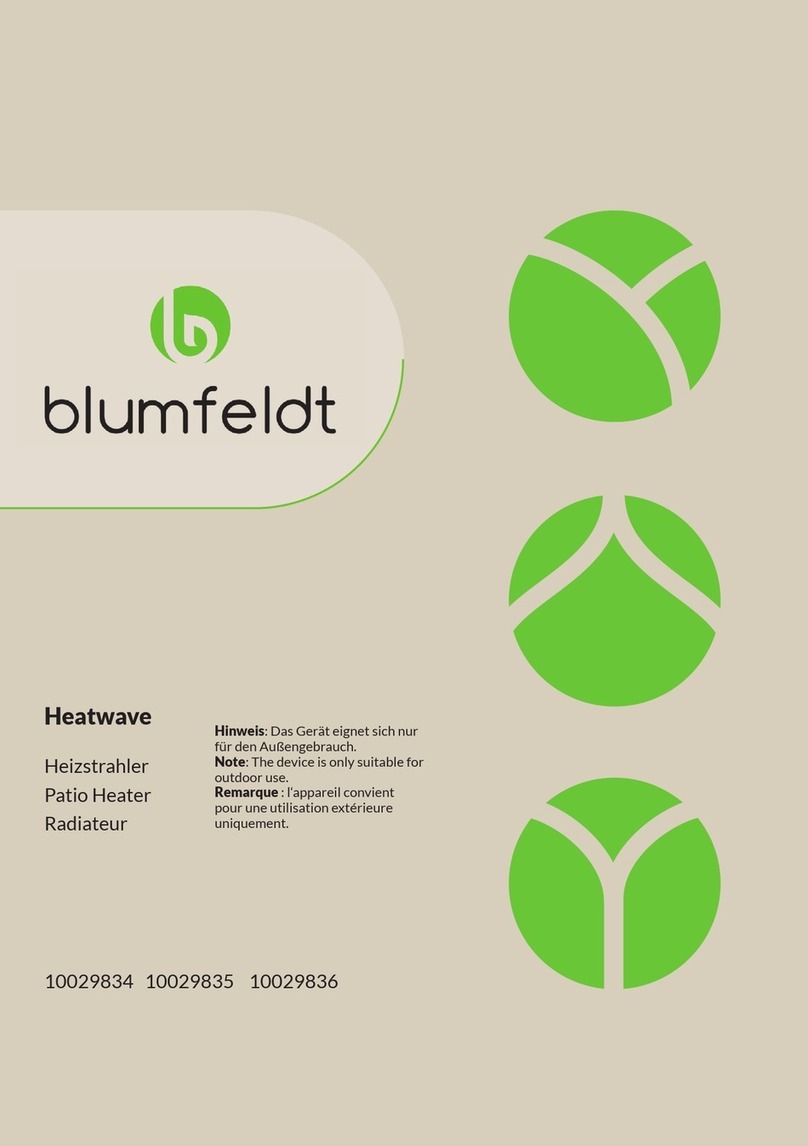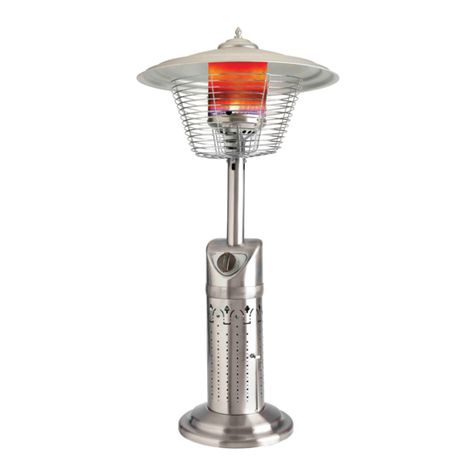Infrared Dynamics PSA 265 Instruction manual

P/N: 65132-11/20 Copyright © 20209 By Infrared Dynamics, Inc. Printed in USA
INSTALLATION, OPERATION & MAINTENANCE MANUAL
SungloTM Patio Heaters
MODEL PSA265 (V,E)
MODEL A242
MODEL A244 (V,E)
For either indoor or outdoor installation.
NOT FOR USE IN RESIDENTIAL DWELLINGS
DANGER
`
FOR YOUR SAFETY – If you smell gas;
1. Open windows.
2. DO NOT try to light any appliance.
3. DO NOT use electrical switches
4. DO NOT use any telephone in your building
5. Leave the building immediately
6. Immediately call your local gas supplier after leaving the
building. Follow the gas supplier instructions.
7. If you cannot reach your gas supplier, call the Fire
Department.
WARNING: FIRE HAZARD
Do not store or use gasoline or other
flammable vapors and liquids in the vicinity of
this or any other appliance. Failure to follow
these instructions can result in death, injury or
property damage.
WARNING
.
Improper installation, adjustment, alteration, service or
maintenance can cause property damage, injury or death.
Read the installation, operating and maintenance instructions
thoroughly before installing or servicing this heater.
Manufactured by
Infrared Dynamics, Inc.
Yorba Linda, CA 92886 U.S.A
Toll Free (888) 317-5255
www.infradyne.com
WARNING: California Prop 65
WARNING: FIRE AND EXPLOSION
If not installed, operated and maintained in accordance with the
manufacturer’s instruction, this product can expose you to
substances in the fuel or from combustion including carbon
monoxide which can cause death or serious illness and which are
known to the State of California to cause cancer, birth defects or
other reproductive harm. For more information go to
www.P65WARNINGS.CA.GOV
Installation and replacement of gas piping, gas
utilization equipment, or accessories, and repair
and servicing of equipment shall be performed
by a qualified agency familiar with all
precautions required regarding type of
equipment and that has complied with all
requirements of the authority having jurisdiction
TO THE INSTALLER: Please read and understand all instructions prior to installation. Give a copy of this manual to
the owner after installation.
TO THE OWNER: Keep this manual in a safe place to retain for future reference

Sunglo™ Infrared Heaters
2
TABLE OF CONTENTS
Section 1. For Your Safety................................................................................................. 3
Warning Symbols ..............................................................................................................3
Applications......................................................................................................................3
Hazards.............................................................................................................................3
Section 2. Owner’s Manual............................................................................................... 5
Before Starting Your heater ..............................................................................................5
Starting and Shutting Down your Heater ...........................................................................5
Performing Routine Maintenance .....................................................................................5
Warning Labels .................................................................................................................5
Stainless Steel Care...........................................................................................................5
Before You Remodel .........................................................................................................5
Basic Lighting Instructions.................................................................................................6
Section 3 Heater Layout and Design................................................................................. 7
Effective Coverage ............................................................................................................7
Where to Locate Patio Heaters .........................................................................................7
Using Multiple Heaters .....................................................................................................7
Section 4. Installation ....................................................................................................... 8
Receiving Equipment ........................................................................................................8
Code Requirements ..........................................................................................................8
Gas Supply ........................................................................................................................8
Clearance Requirements...................................................................................................8
Fire Sprinklers...................................................................................................................9
Electrical...........................................................................................................................9
Ventilation........................................................................................................................9
Gas Piping.........................................................................................................................9
Initial Start-Up ..................................................................................................................9
Section 5. Heater Models ................................................................................................. 10
PSA265 and PSA265V........................................................................................................10
A242 .................................................................................................................................13
A244 and A244V ...............................................................................................................15
PSA265E and A244E (‘E’ Series).........................................................................................17
Section 6. Maintenance and Trouble Shooting................................................................. 19
Sunglo Head Assembly ......................................................................................................19
DSI Ignition System ...........................................................................................................20
Basic Heater Disassembly..................................................................................................21
Service Check List..............................................................................................................22
Trouble Shooting ..............................................................................................................23

Sunglo™ Infrared Heaters
3
FOR YOUR SAFETY
Application
This is not an explosion proof heater. Consult your local Fire
Marshall, insurance carrier and other authorities for approval of
the proposed installation
SungloTM heaters are designed certified for commercial indoor/outdoor and residential outdoor applications.
They are NOT approved for use in any inside residential dwelling. This includes, but is not limited to, attached
garages, living quarters, solarium, etc. Consult your local Fire Marshall and/or insurance provider if unsure of
your application.
Warning Symbols
Safety is the most important consideration with installing, operating, and maintaining this gas heater. You will
see the following symbols and signal words when there is a hazard related to safety or property damage
DANAGER indicates there is an immediate threat
which if not avoided could result in death or injury.
WARNING indicates a potential hazardous situation
which, if not avoided, could result in death or injury.
CAUTION indicates a potential hazardous situation
which, if not avoided, could result in minor or
moderate injury.
WARNING
Not for Use in Residential Dwelling.
A residential dwelling is a domicile intended for use by one or more persons and that
includes one or more areas, such as those used for cooking, eating, living, sleeping or a
sanitary facility. A residential dwelling does not include a detached garage, workshop, or
outdoors.

Sunglo™ Infrared Heaters
4
WARNING
Improper connection to gas lines may result in death or serious injury, explosion, poison fumes, toxic
gases or asphyxiation. Connect gas line in accordance to national, state and local codes
Placement of explosive objects, flammable objects, liquid and vapors close to the heater may result
in explosion, fire, property damage, serious injury or death. DO NOT store, or use explosive objects,
liquids and gasoline vapor in the vicinity of the heater
Failure to comply with published clearance to combustibles could result in death or serious injury
and/or property damage.
In locations used for the storage of combustible materials, signs must be posted to specify the
maximum permissible stacking height to maintain the required clearance from the heater to the
combustible. Signs must either be posted adjacent to the heater switch or other off/on control or
other conspicuous location
Hazards Include:
For maximum safety the building must be evaluated for hazards before installing heaters including the following:
•Gas and electrical lines
•Combustible and explosive materials
•Chemical storage areas
•Areas of high chemical fume concentration
•Provision for accessibility to heater
•Adequate clearance around air openings
•
Combustion and ventilating air supply
•Vehicle parking areas
•Vehicles with lift or cranes
•Storage areas with stacked material
•Lights
•Sprinkler heads
•Overhead doors and tracks
•
Dirty contaminated environment
A critical safety factor to consider before installation is the clearance to combustible materials. Clearance to combustibles is
defined as the minimum distance you must have between the heater outer surfaces and the combustible objects.
Consideration must also be made for movable objects that may be placed near the infrared heater. The following is a partial
list of items to maintain clearance from:
Combustible Objects
•Wood
•Paper
•Fabric
•Chemicals
•Wall or Roof Insulation
•Drywall
Movable Objects
•Umbrellas
•Awnings
•Movable Partitions
•Stage Components
•Other heat sensitive objects
•Sprinkler Heads
When installing infrared heating systems, the minimum clearance from combustible materials must be
maintained. These distances are shown on page 8 and on the label attached to the heater. If you are unsure of
the potential hazards, consult your local Fire Marshall, fire insurance carrier or other qualified authorities on
installation of gas-fire infrared heaters for review of your proposed installation.

Sunglo™ Infrared Heaters
5
OWNER’S MANUAL
Before Starting Your Heater
Before you start your heater examine the heater
installation to determine that;
•Areas immediately around the heater including
the air inlet and the flue areas are free from
obstructions
•There is no obvious deterioration of the
heater.
•Portable type heaters must be placed on level
and adequate footing.
Starting and Shutting Down Your Heater
Sunglo heaters can utilize a variety of gas control
systems. With some models it is necessary to
manually light a pilot. Other models have a fully
automatic ignition system. Identify the model of
your heater on the Basic Lighting instructions chart
on page 6 and follow the lighting instructions. If
heater fails to light or does not heat properly
discontinue use of the heater and contact your local
distributor, or qualitied service agency.
Performing Routine Maintenance
Overtime, particularly during longer periods of
disuse, the heater can accumulate dirt and debris in
and around the pilot and burner. Routine
maintenance should be performed at least once a
year by a qualified service technician to insure the
heater is operating properly. More frequent service
may be required for heaters located near
waterfronts
Warning Labels
It is important that warning labels including the
lighting instructions are not removed from the
heater. If labels are damaged, replacement labels
are available from your local dealer or from the
factory
Stainless Steel Care
Stainless steel needs to be cared for like any other
surface. We recommend washing the stainless-steel
post and base with a mild detergent solution and
applying a stainless cleaner to bring back the original
shine. The stainless steel may be expected to
permanently darken around the top of the heater.
Before You Remodel
If you plan to make changes to the patio or building
structure after the heaters have been installed, your
heater installation must be reviewed by a qualitied
agency to ensure that clearances from
combustible materials and ventilation
requirements are maintained after alterations
are complete. When plastic curtains or drops are
used to enclose a patio, you must take steps to
ensure that all Sunglo heaters have the required
permanent access to outside air. If the patio is to
be partially enclosed a qualitied agency familiar
with this type of heating equipment must be
consulted to ensure the safe operation of the
equipment.
Basic Lighting with the Sunglo™ Manual Control
(see lighting instructions pertaining to your
heater model (on page 6.)
High Altitude Installations
Installation of this appliance at altitudes above 2,000
Ft (610 m) shall be in accordance with local codes, or
in the absence of local codes, the National Fuel Gas
Code, ANSI Z223.1/NFPA 54 or the National Standard
of Canada, Natural Gas and Propane Installation code,
CSA B149.1

Sunglo™ Infrared Heaters
6
BASIC LIGHTING INSTRUCTIONS

Sunglo™ Infrared Heaters
7
HEATER LAYOUT AND PATIO DESIGN
There are a number of
considerations in determining the
type and number of heaters to be
used and their best location on
your outdoor patio.
Concept of Patio Heating. Hot air from
conventional heaters is not an option for
heating an outdoor patio so a patio heater
uses radiant heat like we receive from the
sun
Radiant Heat: Is the type of heat you
receive from a fireplace, potbelly stove, or
the sun. It is an infrared wave length that
heats objects without first heating the
intervening air. Unlike ultraviolet light
there is no sunburn or sun tanning affect.
Infrared will not attract insects
Patio Heater: Is an unvented gas-fired
infrared heater designed to
concentrate radiant heat in outdoor
areas.
Definition of Outdoors: (for the
purpose of these instructions). An
appliance is considered to be outdoors
if installed with shelter no more
inclusive than:
1. With walls on all sides but with no
overhead cover.
2. Within a partial enclosure which
includes an overhead cover and no
more than two side walls. The side
walls may be parallel, as in a breeze
way, or at right angles to each
other.
3. Within a partial enclosure which
includes an overhead cover and up
to three side walls, as long as 30%
or more of the horizontal periphery
of the enclosure is permanently
open.
EFFECTIVE RANGE
(COVERAGE):
The comforting warmth from a single
Sunglo™ Heater will cover a 12’ to 20’
circle. The Sunglo™ is a “comfort”
heater, and the coverage is the area in
which people will receive a comforting
amount of warmth. Some people will
require more or less warmth than
others to be comfortable and will
either turn the heater up or down, or
move closer or farther away as desired
WHERE TO LOCATE PATIO
HEATERS:
Sunglo™ Heaters naturally attract
people to their infrared warm glow.
Locate heaters where people can
readily gather, sit or stand comfortably,
and where furnishing can easily be
moved to best accommodate the
radiating warmth.
GENERAL RULES FOR
LOCATING HEATES:
A Sunglo™ Patio Heater can operate
effectively to maintain comfort even in
completely exposed areas, although
weather protected areas are desirable.
Weather and wind protection allows
the air to be warmed to enhance the
direct radiant warming effect.
Breezy Conditions:
Sunglo™ heaters are designed to work
well under a variety of outdoor
conditions. However, wind and other
weather conditions will affect how well
the heater operates, or if it should be in
use at all. The heater can be safely
operated when the cross wind or
breeze is 0-10 mph. If heaters are
mounted on the edge of a precipice or
sea cliff where wind is directed upwards
into the reflector hood, damage to the
heater will occur. Upward thrusts of
wind can also occur because of wind
walls or other architectural elements
near the patio. The patio should be
designed to protect the heaters against
this type of condition.
Using Multiple Heaters:
When more than one heater is used in
an area, it is generally preferable to
locate them close together. Multiple
heaters located on 8’ to 15’ centers will
give overlapping heat patterns,
increasing the overall effective coverage
for each heater.
CONTROL SYSTEMS:
Sunglo™ heaters are available with a
variety of control systems from manual
controls requiring no electrical
connections to a 24 VAC fully automatic
ignition and control system (see Basic
Lighting instructions on page 6). It is
recommended that when multiple
heaters are used, that the electrical
circuitry be arranged so heaters can be
switched on and off individually or in
groups to provide maximum flexibility
for heating the patio.

Sunglo™ Infrared Heaters
8
INSTALLATION AND SERVICE INSTRUCTIONS
Receiving Equipment
On receipt of equipment it is suggested that a visual inspection be
made for external damage to the carton. If the carton is damaged,
a note should be made on the Bill of Lading when signing for the
equipment. Remove the heaters from the carton. If there is
damage, report the damage to the freight carrier immediately.
Each Sunglo™ heater is carefully tested and adjusted at the
factory. Before attempting to install this equipment a thorough
inspection is required to insure the heaters are in the original
condition from the factory. Check for any loose parts or damage
such as dents or parts that may affect the operation of the heater.
If there is any question in regards to the condition of the
equipment, contact the factory.
INSTALLATION INSTRUCTIONS
Important Notice
These instructions are intended for qualified personnel, specifically
trained and experienced in the installation of this type of
equipment and related system components. Some states or
provinces require installation and service technicians to be
licensed. If your state or province is such, be sure your contractor
bears the appropriate license. Persons not qualified shall not
attempt to install this equipment nor attempt repairs.
Code Requirements
Installation must be in accordance with local codes, or in absence
of local codes, with the latest edition of the National Fuel Gas
Code, NFPA 54/ANSI Z223.1 and the National Electrical Code
ANSI/NFPA 70, and for Canada, the latest edition of CAN/CGA-
B149.1 and B149.2 and Canadian Code CSA C22.1 Part 1 and Part
2.
Heaters to be installed in Aircraft hangars must be installed in
accordance with the American National Standard for Aircraft
hangars, ANSI/NFPA No. 409.
Heaters to be installed in Public Garages must be installed in
accordance with NFPA No. 88A, Standards for Parking Structures.
Heaters must be installed so that minimum clearances marked on
the heater will be maintained from vehicles parked below the
heater.
When an external electrical source is utilized each heater must be
electrically grounded in accordance with the National Electrical
Code ANSI/NFPA 70. In Canada, the Canadian Electrical Code CSA
C22.1 Part 1 applies.
Gas Supply
The gas inlet supply pressure and manifold pressure
required for each heater are listed below. For gas supply
line pressures in excess of ½ psig, consult your natural gas
representative or the factory.
Gas Inlet Pressure Nat Gas Propane
Maximum Pressure ½ psig 11 W.C.
Minimum Pressure 6 W.C. 11 W.C.
Manifold Pressure 5 W.C. 11 W.C.
It is important that the gas piping system be adequately
sized for all the gas appliances it serves.
Clearance Requirements
Each heater must be installed such that the following
“Minimum Clearances from Combustible Materials” are
always maintained.
Combustible materials include all wood, compressed
paper, plant fibers, plastics, Plexiglas and other materials
capable of being ignited or burned. Such materials shall
be considered combustible even though flame-proof, fire
retardant treated or plastered. Additional clearance may
be requited for vinyl siding, glass, painted surfaces or
other materials that may be damaged by radiant or
convection heat.
Clearance from Combustibles
Top 18 inches 46 cm
Side 24 inches 61 cm
Below 84 inches 214 cm
Fire Sprinklers
Fire Sprinklers must be located at an appropriate distance
from each heater to avoid accidental activation of the
sprinkler. Ethylene glycol or propylene glycol must never
be used in fire sprinkler systems where heaters are
present, as these substances may become flammable
when heated. A fire sprinkler professional must be
consulted when heaters are installed to insure heaters
and fire sprinklers are properly integrated. Specific
guidelines can be found in NFPA 13, Installation of Fire
Sprinkler Systems.

Sunglo™ Infrared Heaters
9
Electrical (V,E) Models Only
These heaters require 24 VAC to operate. The
installer must provide a NEC Class 2 transformer.
Each heater requires 20VA or 0.8 amperes
(AMP). When multiple heaters are connected to
one transformer, that transformer must be sized
to accommodate the entire electrical load.
Control wire used to electrically connect one or
more heaters together must have adequate
capacity and insulation temperature rating for
the total connected load. Use at least 18 GA wire
up to 50 feet from the heaters to the
transformer or wall switch. Use minimum of 16
GA wire for over 50-foot distances.
If any of the original wire supplied with the
heater must be replaced, it must be replaced
with wiring having a temperature rating of at
least 105 centigrade.
Ventilation
1. It is required that areas above and below
the heater be properly vented to allow
for necessary combustion air and removal
of combustion gases.
2. Heater shall be provided with natural or
mechanical means to supply and exhaust
at least 4 cfm per 1,000 BTU per hour of
heater input. Exhaust opening for
removing the flue products shall be above
the level of the heaters.
3. Heater ventilation must comply with
state and local codes.
Gas Piping
1. A minimum pipe size of ½” is required for
inlet piping. A ½” lever handled shut-off
gas cock must be installed within 6 feet of
the heater for servicing the unit.
2. Gas lines must be adequately sized to
carry the total connected gas load. Check
with local and state plumbing and heating
codes regarding sizing of gas line.
3. All gas pipe connections to the heater(s)
must be sealed with a gas pipe compound
resistant to liquefied petroleum gases.
4. Installation of a drip leg in the gas supply
line going to each heater is required to
minimize the possibility of any loose scale
or dirt within the gas supply line from
entering the heater’s control system.
5. When checking for gas leaks do not use
an open flame. Use a soap and water
solution.
6. 6. For gas supply line pressures in excess
of ½ psig, consult the factory or your local
natural gas representative.
7. Installation of a 1/8” N.P.T. plugged
tapping accessible for test gage
connections is required upstream of the
gas supply connections to the heater.
Initial Start-Up Procedure
1. Make sure the gas lines are completely purged of
air before attempting to light heater.
2. Follow lighting instructions on page ?? for your
particular model.
3. Check all gas connection for leaks using soapy
water.
4. Flame should travel completely around the inside
of the emitter grid.
5. Emitter grid should become RED within 5
minutes (this may be difficult to see in bright
sunlight).
NOTE: Some white smoke may appear during or
just after the initial start-up of the heater. White
smoke will dissipate with procedure.
Servicing Instructions
Service checks on these heaters should be
performed at least annually or more frequently
depending on their use to verify the proper
operation of these heaters. If the pilot fails to light
or the heater does not heat properly the heater
must be repaired before being put back into service.
1. Turn off gas and electrical before attempting
to any service.
2. Remove reflector and emitter assembly from
heater as shown on page 21.
3. Using low pressure air (maximum of 30 psig)
clear burner and pilot of any dirt or debris.
NOTE: Appropriate eye protection must be
worn).
4. Using a metal brush remove any accumulated
dirt from the inside of the emitter grid.
5. Reassemble heater and observe whether
heater has been restored to proper operation.
6. If heater does not operate properly it may be
necessary to remove burner and orifice for
cleaning.
7. Any corroded or deteriorated parts must be
replaced.

Sunglo™ Infrared Heaters
10
HEATER MODELS

Sunglo™ Infrared Heaters
11

Sunglo™ Infrared Heaters
12

Sunglo™ Infrared Heaters
13

Sunglo™ Infrared Heaters
14

Sunglo™ Infrared Heaters
15

Sunglo™ Infrared Heaters
16

Sunglo™ Infrared Heaters
17

Sunglo™ Infrared Heaters
18

Sunglo™ Infrared Heaters
19

Sunglo™ Infrared Heaters
20
Other manuals for PSA 265
1
This manual suits for next models
6
Table of contents
Other Infrared Dynamics Patio Heater manuals
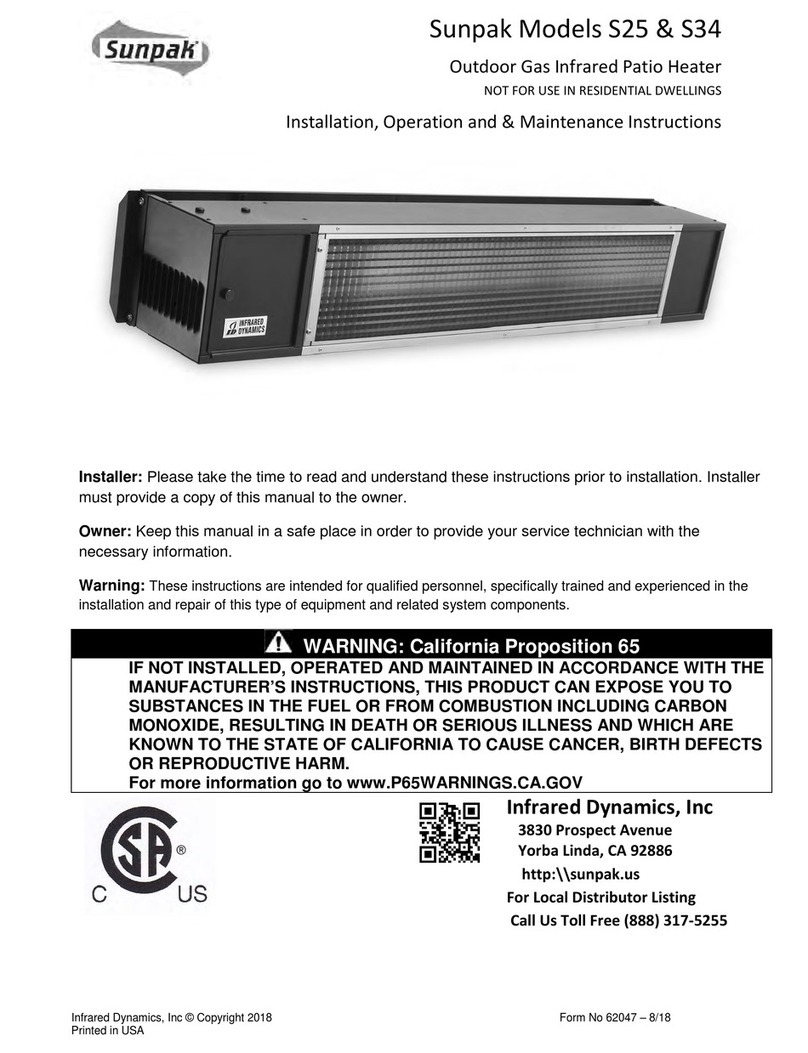
Infrared Dynamics
Infrared Dynamics Sunpak S25S Manual
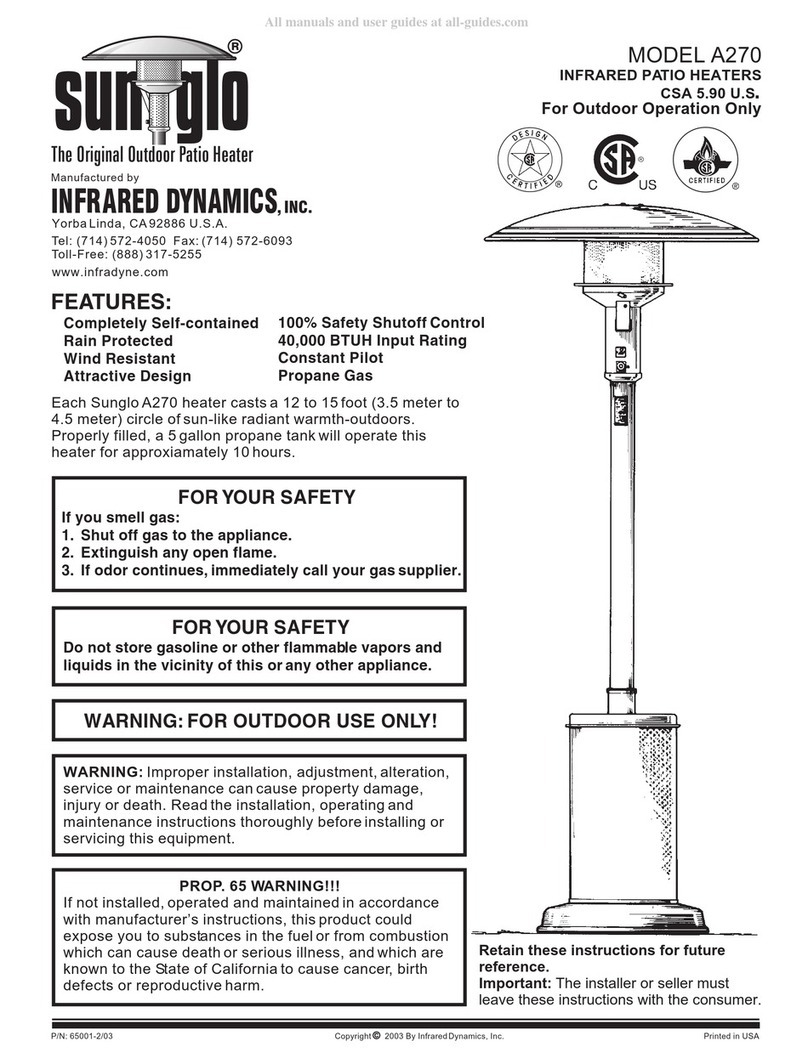
Infrared Dynamics
Infrared Dynamics Sunglo A270 User manual
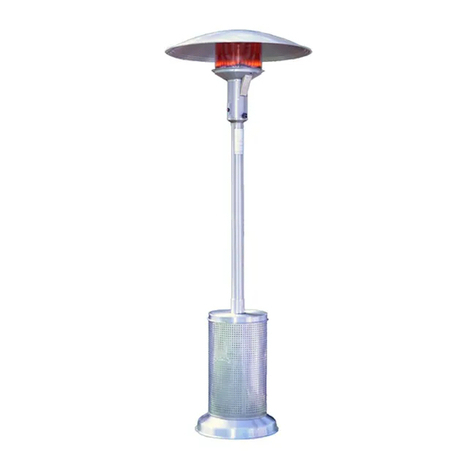
Infrared Dynamics
Infrared Dynamics Sunglo A270 Troubleshooting guide
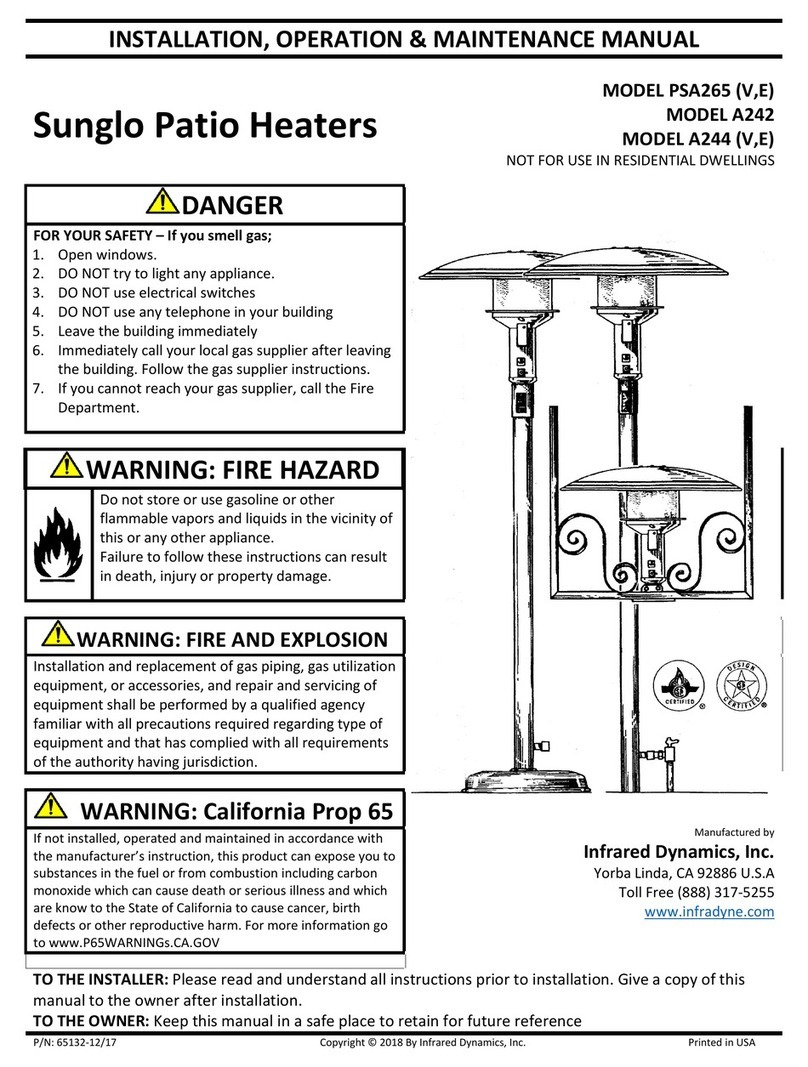
Infrared Dynamics
Infrared Dynamics PSA 265 Instruction manual
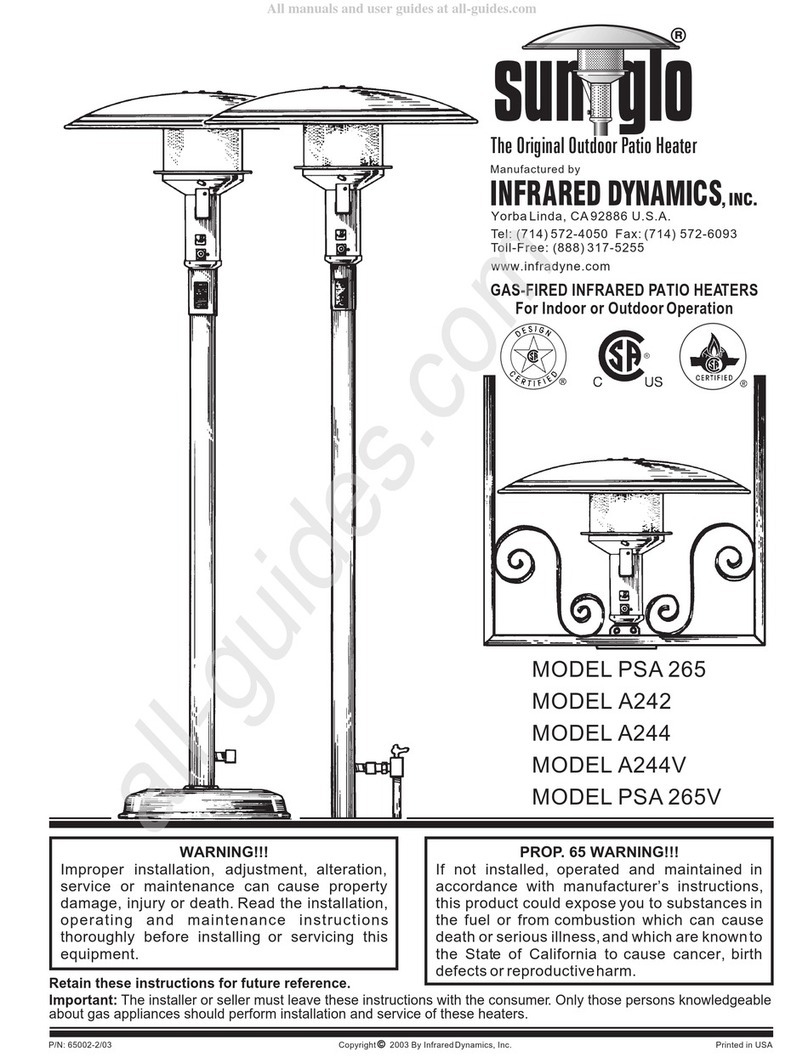
Infrared Dynamics
Infrared Dynamics Sun Glo A242 User manual

Infrared Dynamics
Infrared Dynamics Sunglo A270 Manual
